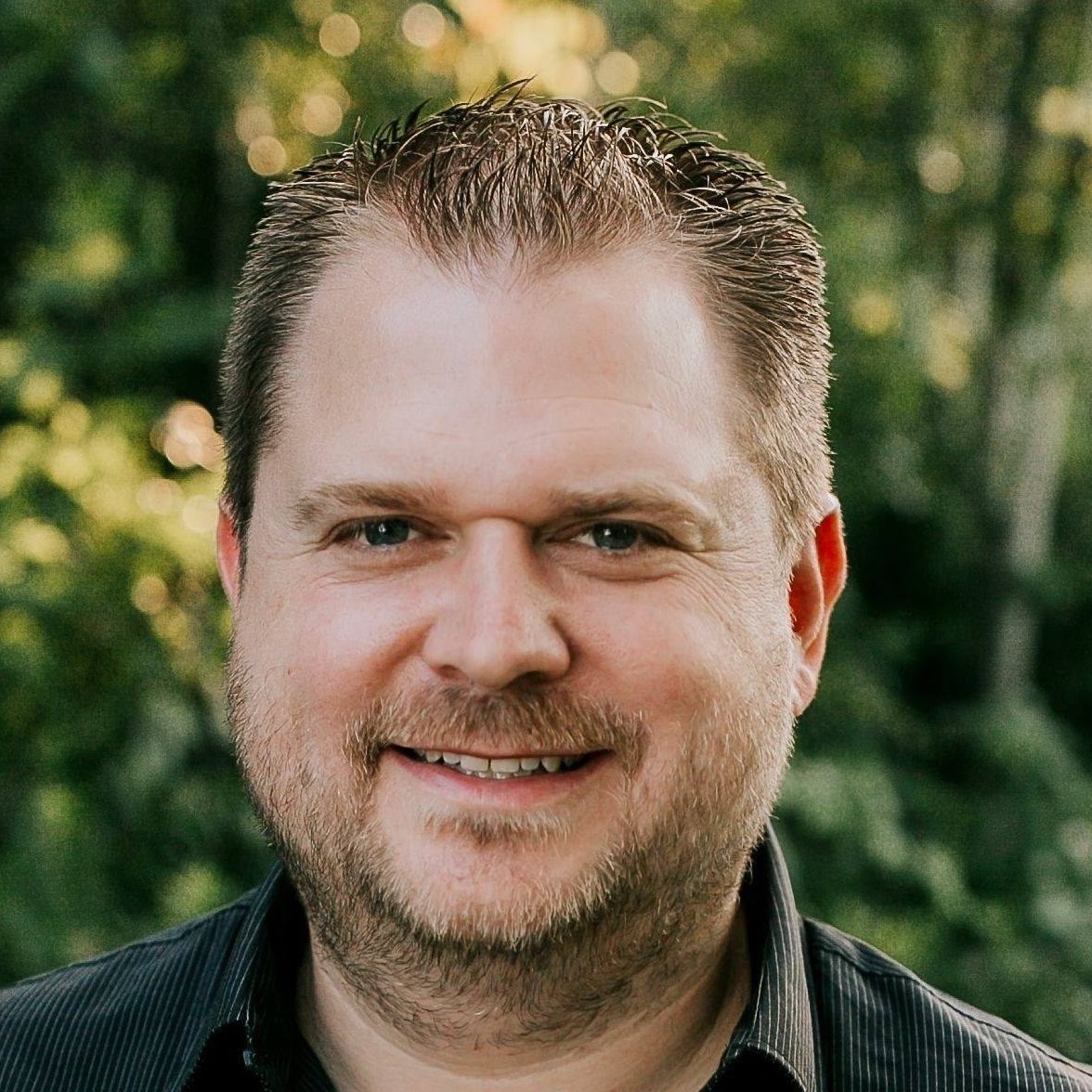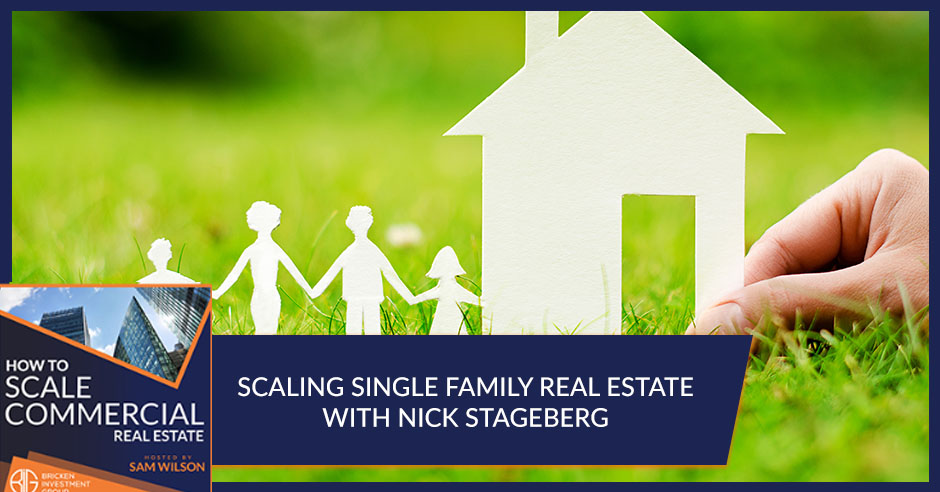There are many myths in real estate, and one of them is that you cannot scale single-family. However, as our guest proves, you just need the right system for the job. In this episode, Sam Wilson talks about scaling single-family real estate with real estate investor and Black Swan Real Estate owner Nick Stageberg. Nick shares how he scales single-family, his work processes, and his plans in the property management space. Curious about real estate and single-family? Then tune in and learn more.
—
Watch the episode here:
Listen to the podcast here:
Scaling Single Family Real Estate With Nick Stageberg
Nick Stageberg is an Active Real Estate Investor and Owner of Black Swan Real Estate. He wholly owns $25 million of real estate assets and manages over $100 million in assets under the management of both single-family homes and large multifamily communities with investment partners. They will be launching their private equity fund in Q1 of 2022. He’s also a licensed real estate agent in Minnesota. He lives in Rochester, Minnesota with his wife, Elaine, who is a full-time partner in their investments and businesses, and has three amazing children. Nick, welcome to the show.
Thanks. It’s a pleasure to be here.
The pleasure is mine. The same three questions I ask every guest who comes on the show are, can you quickly tell us where did you start, where are you now, and how did you get there?
I started the way a lot of people start doing sweat equity remodel. It’s kind of a BiggerPocket’s vision of wealth as a lot of people see it. I spooled up to about twenty of those over the course of many years. I picked up a few properties a year and finally got to retirement. I don’t know if you’ve ever been to a Tony Robbins event but it so happened that my path is guided. I got a free ticket to this Tony Robbins event with my wife that happened to be the day after I quit my day job. After fifteen years in IT, I was like, “I’m retired.”
I’m going to take it easy for a while. I’ve got my $80,000 a year in passive income. I’m set for life and not sure what I’m going to do. If you go to one of those events, Tony gets you jacked up. He says, “If you’re not sure what to do with the steering wheel, put the pedal to the metal and you’ll figure it out real fast.” He’ll also challenge you and say, “Is your business successful as you want it to be?” Everyone there says no. He says, “It’s because you’re not listening to your customer.” I was like, “I had to make up this metaphor for turning away businesses.”
Everyone would come to me all the time and say, “Can you create for me the thing that you’ve created? You’ve got all these properties in passive income. Can you buy properties for me and manage them?” I had to make up a script to streamline turning away business and I’d say, “I love raising my own kids but I don’t want to open a daycare.” Tony will challenge you and say, “Tell yourself, ‘I don’t want to do that,’ but you should be asking yourself, ‘Who can I hire to do that? How can I do that? How can I serve these people?’” I left that event and said that I wanted to 10X, 100X, or whatever.
We had less than $5 million in assets a few years ago, and we have over $100 million assets now just by serving people and leaning into those operative questions. Now, we buy a lot of single-family homes. We’ve got our core single-family at scale. You can do single-family at scale if you have good systems and processes, and you do it all identically. You can use a lot of the same stuff you do in multifamily and single-family homes. We will buy ten apartment deals in 2021.
That’s where we’re at now and we’re doing a $40 million ground-up construction project of a townhome community too. It’s not anti-profitable but it’s a lot of fun to go out there and see bulldozers pushing dirt around and slabs going in the ground and stuff. I feel like a kid at a playground with one of those little excavators with the handles but on a bigger scale.
If you’re not sure what to do with the steering wheel, just put the pedal to the metal, and you’ll figure it out real fast.
That’s a lot of growth and moving pieces in a very short period of time. Let’s tackle a common myth that single-family cannot be done at scale. Can you dispel that myth for us?
Most people don’t approach it with a systematized process. We have a pipeline that things go through. I have a tech background and we use all the same systems, processes and tools. We use Trello to manage all of our renovations. People say, “You can’t manage more than ten residential remodels and stay sane.” We have a Trello board. Each job site is like a card on that Trello board. We’ve got a Google Doc for a scope of work. There’s not a single piece of paper or phone call in that whole pipeline.
We use the same light fixture, paint color and everything in every single one of our remodels. All of our contractors know exactly what skews to use. We never have to say, “In this one, we’re going to do this.” There are a tiny bit of differences but we use the same financing pipeline, management for everything, policies and procedures. We have the same fencing contractor install the exact same fence in every single one of our properties. There’s not a lot of touch to it.
The truth is that single-family runs a much lower expense ratio than multifamily because you aren’t paying for utilities. In our area in Minnesota, snow removal is a big deal. The resident manages snow removal and lawn care. They also tend to be lower maintenance if you find the right residents that are less needy tenants. Our single-family runs a lower expense ratio than our multifamily. You have to nail down the management and stay sane with the management. If you do it right and get good systems and processes in place, it can be done. We feel strongly about that.
We give away our whole playbook. We have our course, SingleFamilyAtScale.com. We give it all away for free. We think the way we do business makes the world a better place. It’s a pay-what-you-want model for the course and 100% of that profit goes to charity because we think it’s not right that being a landlord or a tenant could be a pejorative. How crazy is that? If you do business the way we do business, it will eventually move the needle ever so slightly on that perception.
That’s one of the things that people struggle with. A common business struggle is processes, especially on the single-family side. How do you communicate this stuff to your contractors? Is it the same contractor that you guys use on every single project?
Yes, it’s the same group of contractors. We’ve got a few different plumbers, HVAC guys, and electricians. It’s the same group of people. You have to be pretty aggressive about it on the front end. We refuse to write checks so they must enroll in our property management software. We run all the rehabs through our property management software for EFTs for managing all the accounting. It’s those little things like that that will make you lose your mind trying to run a whole bunch of different rehabs and single-family homes.
If you can’t give us a W-9, proof of insurance, and enroll in EFTs, I’m sorry but we can’t do business with you. Maybe at first, the contractor says, “That’s not worth it. I’ll go do something else,” and then a few months later, they come back. You take good care of your contractors and you pay them very promptly. We do electronic payments, you get paid 24 hours after we receive an invoice. There’s none of this 30 net $0.99 that a lot of people try to string along their contractors there. Make sure your contractors see the value proposition in your standardization.

I know that you like to use this faucet. This is the faucet that goes in every single one of our properties. If that doesn’t work for you, this isn’t a good fit. It’s a struggle at first, and then at some point, there’s an a-ha moment. It’s funny because I’ll go out and visit with our contractors every now and then. I love going out to lunch with them or I’ll go visit a job site and give them some face time. Maybe at first, they pushed back on some of these systems and processes, and then a year later, I see that they’ve got the tablet that we recommend they get with the Trello board and the Google Doc pulled up. I can see they’re managing all of their job sites the way we manage our job sites, and that’s great.
They steal our secret sauce and our contractors will eventually say, “I make so much more money when I work with you. I don’t know why but I do.” They don’t even necessarily realize how much overhead they’re saving by using all those systems and processes. It’s tough at first. You have to say no to a lot of contractors that refuse to do business the way you do business. In the long run, in my experience, they always thank you for it.
Even inside of that system, I’m sure you’ve found a way to extricate yourself from that onboarding process. That’s the thing I love about it. The building system is like you build one and then you build another. It’s an iterative process.
We have a DocuSign, so everything we need goes into that DocuSign template. It’s a one-stop to onboard that contractor. We’ll even serve them, “Come on into the office. We will walk you through it shoulder-to-shoulder but you have to go through this process. You cannot give us a piece of paper with your insurance information on it.”
It’s the same way with the tenants, “You’ve been paying in cash to your previous landlord for the last 30 years. I’m sorry but we don’t accept cash. It’s a safety concern. You say you don’t know how to use a computer but I see you’ve got a smartphone in your hand while we’re talking here. Let me go shoulder-to-shoulder with you, get you set up in the app, and set up an automatic recurring monthly rent payment.”
They’ll go, “No, I’ll write you a check.” “I’m sorry but we’re going to have to assess you a check processing fee if you do that. We don’t want to collect that fee and we don’t want to manage the check, so we’re going to aggressively and uncomfortably serve you. Maybe this is the first smartphone app you’ve ever used next to Facebook, but you are going to sign into the app and you are going to set up automatic recurring monthly rent payments. I may not leave your apartment until you do.” It’s all about maintaining that consistency and that’s the only way to stay sane at scale.
The truth is that single-family runs a lower expense ratio than multifamily because you aren’t paying for utilities.
What do you do with your tenants that don’t have a bank account?
We can accept PayNearMe. We will accept checks, money orders, cashiers check, and certified funds only if delivered to a secure location. We will follow up with someone monthly and say, “I appreciate you paying rent. I see you paid by a check but I’m obligated by our process to give you a call and remind you that we don’t like getting checks, and you’re paying a fee to pay with a check. Can I give you a ride to the bank?”
People are uncomfortable with it at first but they’ll get that you’re approaching them from a sincerely loving perspective and you have their best interests in mind. I could give you a lot of very interesting stories but we have been able to serve people in big ways. In the end, we come out all the better for it. We’ll take over a new multifamily community and have 30 checks roll in that first month we collect rent. We’re like, “How did anyone do this for so long?”
After a couple of months, maybe three checks roll in. Six months later, zero checks roll in and it’s instant. We’ll misplace a couple of checks for a few thousand dollars because it’s so easy to do when you’ve got a whole bunch of checks rolling in. We’re like, “This is unbelievable.” It’s hard to do the work on the front end and you have to be willing to have an uncomfortable conversation. If it’s not a good fit, it’s not a good fit. We’ll tell people, “If you prefer to write checks, maybe we’re not the landlord for you. There are lots of great landlords out there that will accept checks.”
It’s amazing how those little things occupied brain space. It can end up having your day filled with all this little stuff that adds nothing to the bottom line. It’s amazing when you implement small systems like that and how much that stuff stacks up quickly.
We’ll do it in a big way too. We took over an 83-unit apartment building. It has an office for the manager and the maintenance manager for that building. We declined to staff that office. We have an extraordinary level of customer service. We always answer the phone and respond instantly to emails and text messages that come into our property management software. If you don’t use our systems for communicating, we’re deliberately a little less responsive to try to steer you to those systems.
At first, people freaked out a little bit that we weren’t staffing the office, and then they saw that level of customer service that we were able to deliver. Part of me admires the idea that you can walk into the office anytime and have a half-hour conversation with the building manager. That ownership is a valuable thing but that’s also an extraordinary waste of time. It makes it easier to take checks because you can go drop off a check with your building manager and suddenly, a whole bunch of inefficiencies collapse. They disappear as soon as you take away that building manager.
We still have the office. We can have a person on-site in ten minutes if there is an emergency. We had a false fire alarm before. We had three people on-site in eleven minutes. We declined to staff that office because we find it introduces unreal amounts of overhead and inefficiency that violate our processes. You got to have to be disciplined about it in order to do this at scale.

Hats off to you guys for developing those systems and putting in the work upfront. Every entrepreneur’s nightmare is getting those systems and processes done. That’s fantastic. Tell us again about your website before I forget about it. Where can people download your blueprint?
Go to SingleFamilyAtScale.com and we give away everything from the light fixture we install. Everything from our management systems to our financing systems, we’d give it all away there more or less for free.
We are running short on time, but there are a couple of things I want to make sure I highlight because you guys aren’t just doing single-family. You are buying an 83-unit property and are closing ten multifamily deals in 2021. You guys are moving but there’s one that I’d love to hear the story on because it’s going to have some intriguing insight. You’re closing a $23 million contract for a deed deal. First off, we don’t talk about this a lot on this show because I find a lot of contract for deed stuff done on the single-family side because this is a commercial show. Tell us what a contract for deeds is and then walk us through the deal.
Usually, a contract for deed is a single-family thing. We do single-family and commercial multifamily. I’ve never heard of a contract for deed on a deal anywhere near that size so it’s a neat story. A contract for deed basically says that the seller or current owner is the bank. Most commonly, it’s used when the buyer has poor credit or poor ability to buy. It can sometimes be considered a predatory instrument but that’s a misperception.
For example, if you go out to agricultural land, a contract for deed land contracts are extraordinarily common. Farmer Jane buys a farm field from farmer Joe on a contract for deed. I’m sure many people on the show have encountered situations where there is a monstrous pre-payment penalty on a loan, and the owner of this building had bad luck. They locked in a swap agreement before COVID hits. They locked in a high-interest rate loan relative to interest rates now. How the swap contracts work is if interest rates have gone down since you locked it, you pay huge pre-payment penalties.
This is a large loan. It’s a $23 million deal. It’s a terrible lock for the seller of each bad timing and everything. We said, “We can give you this price if we make a clean purchase.” That didn’t spiritually or emotionally satisfy them. They would have to pay this huge pre-payment penalty in addition to that lower price or we can offer them a contract for deed purchase. With that contract for deed, we’ve already gotten approval from the lender that we have a great relationship with. We’re going to take over their existing unfavorable loan. We’re going to make all the payments on that loan.
You’re going to carry the balance, no interest and payments essentially for up to seven years until that pre-payment penalty wears off on your current loan. We’ll then do a refi in order to wipe out that loan and return the balance to you. At the end of the day, it’ll be a 10% down with otherwise extraordinarily favorable financing terms when you’re getting no interest and no payments on even a portion of a $23 million deal for seven years. You can imagine what that does to your rates of return. The end outcome is let’s say, interest rates bump up three years from now, sometimes it wears off on that swap contract. That’s going to reduce that pre-payment penalty to zero.
A few years from now, we’re going to be able to do a little bit of value add and raise rents. It’s nothing too exciting but the usual business plan where we’ll be able to do a cash-out refi. We will never put more than 10% down on what is otherwise a dynasty asset, a very premium class-A community in the urban core location. We might get five times the typical rate of return you might otherwise get on a deal of this nature. The seller will get an additional $5 million or something like that when all was said and done. It’s a win-win deal but it takes a lot of creativity to put it all together and make sure everyone understands that it’s a win-win deal.
Many people drive their investment decisions from a spreadsheet, which can get you into a dangerous place.
They are getting $5 million later on the deal. Why are they even selling it now? Why not do what you’re doing and write it out for seven years?
To be clear, the building is not publicly marketed. We have specifically targeted this building and built a relationship with the person who built it. There are builders in our townhome community that made a relationship with the developer who developed this deal. This is the asset where you can’t knock down buildings to build them. They had to pick up and move buildings to build this asset. It’s in that premium of a location. It’s skilled development work to make that happen. We’ve built strategic relationships with these other parties in order to be able to get a deal proposition put together for the seller.
At first, the seller was like, “The contract for deed isn’t what people do when they don’t have money, credit or whatever.” No, this is how you can sell the asset at a 2023 price now. We’re going to put down a couple of million dollars, so there’s no way you can lose here. We then get some very favorable financing. They hadn’t planned on selling it but we put together an offer that was such a win-win for them. It’s an offer where they couldn’t say no to. It’s been a six-month negotiation process on it going from a seller who wasn’t interested in selling to, “We are crazy to say no to this offer.” It’s a slow process.
The fortune is in the follow-up. I don’t know what flipped the switch for them to sell. They weren’t very interested and we kept the dialogue going. All of a sudden, they came back. Maybe there’s a change in health or they want to do an around the world cruise. It’s a very wealthy family. They don’t need the money and this is just one of many businesses that they operate. They’re a very successful family and they decided one day, “If we can get this money, we’re crazy to say no.”
I have certainly enjoyed this, Nick. Tell us quickly about your private equity fund. Tell us what you guys are doing with that and when that’s going live.
We are unbelievably excited about that. We hope it disrupts that space in the same way we hope to disrupt the property management space with our unique approach to property management. It’s going to be a private equity fund that has no fees. There are no asset management fees, acquisition fees, capital event fees or disposition fees. Usually, you get this Wall Street persona that rounds up capital and then works with a local operator like me, and everyone has taken splits. We’re going to go out and buy single-family and multifamily properties. It’s structured identically to how we structured all of our other deals.
There are no additional fees at that level as well. Our passive partners get 100% of the profit from the deal until they get a full return of capital. It’s a 50/50 split after that. It’s super simple. There’s no catch-up pref, a waterfall, or all kinds of opaque fees and stuff to all these different finance personas. You are investing in real estate. You’re investing with us, so you know exactly what you’re getting.
We expect that it will fill up pretty quickly. We’re unbelievably excited to disrupt that private equity space in our own little way and hopefully, challenge some people’s ideas the next time they’re investing with this Wall Street persona and say, “Why do you need to take a 2% asset management fee, and why is there an extra 20% split on top of what the operator is making that’s doing the deal?” That’s something we’re excited about that will be available here soon.

Nick, few last questions for you. If you could help our readers avoid one mistake in real estate, what would it be and how would you avoid it?
I see a lot of investors that have a very quantitative approach to real estate. I do calls with investors all the time to meet BlackSwanTeam.com and you can block time on my calendar. They’ll frequently say, “I’m looking at this deal. I’ve got this spreadsheet that says I’m going to get a 10% cash-on-cash, so we’re off to the races.” I will pull up Google Maps and Street View. I’m like, “I can see this is not a class-C property. This is more of a class-D property. There’s some garbage in the street.” I’ll say all the warning signs there and I’m like, “This is not going to work out the way your spreadsheet says it’s going to work out.”
This is a qualitative game. The best way you can grow your net worth is to grow your network. I know it’s trite but you should be having lunch or coffee with someone every single day with a broker or a lender. If Warren Buffet came to me and said, “Do you want to invest in my deal?” I’d say yes. I don’t need to see a spreadsheet. It’s Warren Buffet. I’m good. This is a relationship game and a qualitative game. I see a lot of people driving their investment decisions from a spreadsheet and that can get you into a dangerous place.
Nick, if our readers want to get in touch with you or learn more about you, what’s the best way to do that?
Go to MeetBlackSwan.com. We’ve got a fun little video that a media company did that I liked. You can sign up for our newsletters and free educational events, enrol in our course, and check out our free group coaching forum on Facebook. There are all different ways to connect with us. You can block a time on my calendar if you’d like to get in touch and see how we can serve you.
Nick, thanks so much. I do appreciate your time.
Thank you.
Important Links:
- Black Swan Real Estate
- Trello
- DocuSign
- SingleFamilyAtScale.com
- PayNearMe
- MeetBlackSwan.com
- Black Swan Real Estate Team – Facebook
About Nick Stageberg
 Nick Stageberg is an active real estate investor and owner of Black Swan Real Estate. He wholly owns over $25 million of real estate assets and manages over $100 million in AUM of both single family homes and large multi-family communities with investment partners. They will launch their private equity fund in Q1 2022! He is a licensed real estate agent in Minnesota. He lives in Rochester, MN with his wife Elaine, who is a full partner in their investments and businesses, and 3 amazing children.
Nick Stageberg is an active real estate investor and owner of Black Swan Real Estate. He wholly owns over $25 million of real estate assets and manages over $100 million in AUM of both single family homes and large multi-family communities with investment partners. They will launch their private equity fund in Q1 2022! He is a licensed real estate agent in Minnesota. He lives in Rochester, MN with his wife Elaine, who is a full partner in their investments and businesses, and 3 amazing children.

